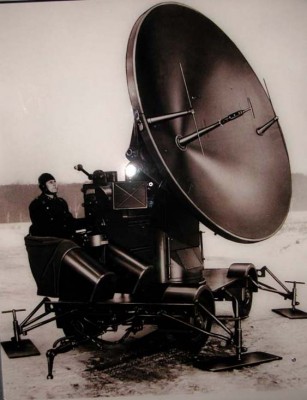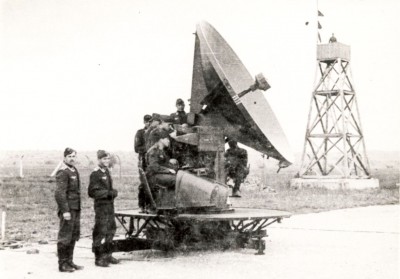| Název: Name: | FuMG 62 Würzburg | FuMG 62 Würzburg |
| Originální název: Original Name: | FuMG 62 Würzburg | |
| Výrobce: Producer: | DD.MM.1939-DD.MM.194R Telefunken, ? | |
| Období výroby: Production Period: | DD.MM.1939-DD.MM.194R | |
| Vyrobeno kusů: Number of Produced: | ~ 4000 (všechny verze / all version) | |
| Prototyp vyroben: Prototype Built: | DD.MM.1939 (FuMG 39 / FuMG 39T Darmstadt?) | |
| Použití: Use: | baterie protiletadlového dělostřelectva / anti-aircraft artillery batteries | |
| Základní charakteristika: Basic Characteristics: | ||
| Funkce: Function: | primární radiolokátor | primary radar |
| Platforma: Platform: | pozemní radiolokátor | ground radar |
| Kategorie: Category: | radiolokátor pro řízení palby | fire control radar |
| Technické údaje: Technical Data: | ||
| Typ antény: Antenna Type: | parabolická anténa | parabolic reflector |
| Pásmo NATO: NATO Band: | pásmo C | C band |
| Pracovní frekvence: Frequency: | 560 MHz | |
| Doba opakování pulsu: Pulsewidth: | ? | |
| Frekvence opakování pulsu: Pulse Repetition Frequency: | 3750 Hz | 0.0002666666666666667 pps |
| Paprsek: Beam: | ? ° | |
| Špičkový výkon: Peak Power: | 11 kW | |
| Provozní výkon: Average Power: | ? kW | |
| Uživatelské státy: User States: | | |
| Poznámka: Note: | Verze: - Würzburg A - základná verzia z roku 1939
- Würzburg B - experimentálna verzia s infračerveným sekundárnym detektorom, nezavedená do výzbroje
- Würzburg C - verzia s dvojicou žiaričov, čím sa zlepšila schopnosť rádiolokátora reagovať na zmeny polohy cieľa
- Würzburg D - verzia vyvinutá z roku 1941, používala rotujúci žiarič s miernou výchylkou (cca 0,1°) osi vyžiareného lúča od osi antény | Versions: - Würzburg A: Basic version from 1939 - Würzburg B: Experimental version with an infrared secondary detector, not deployed
- Würzburg C: Version with a pair of radiators, which improved the radar's ability to respond to changes in target position
-
Würzburg D: Version developed in 1941, used a rotating radiator with a slight deflection (approx. 0.1°) of the radiated beam axis from the antenna axis |
| Zdroje: Sources: | www.radartutorial.eu | |
FuMG 62 Würzburg (střelecký rádiolokátor)
FuMG 62 Würzburg
FuMG 62 Würzburg
The FuMG 62 "Würzburg" radar was developed by Telefunken in 1937, using the experience gained by GEMA and Lorenz, as well as its own experience with the development of the experimental "Darmstadt" radar. The functional device was presented to the army in 1939 under the designation FuMG 39 (later the designation was changed to FuMG 62A "Würzburg"). The device was personally inspected by Adolf Hitler at the Rechlin test centre in July 1939. The radar uses a 3 m diameter parabolic antenna, with the antenna rotatable full-circle in azimuth and in the range 0° to 90° in azimuth. The range of the radar was 40 km with a range measurement accuracy of 80-120 m. The accuracy of angular coordinate measurement (azimuth, bearing) was 1.5°-2°.
Although the indicated values made it possible to track the target, they did not provide sufficient accuracy for the calculation of overrun points necessary for automatic fire control of heavy anti-aircraft artillery batteries (this deficiency was partially eliminated by the use of data from several radars located at different positions for the calculation of battery overrun points).
The radar was also equipped with a target recognition system (own-foreign - IFF), for which two side dipoles located on the antenna served. A prerequisite for successful functionality was that own aircraft were equipped with the FuG 25 "Zwilling" recognition device.
In May 1940, the first shoot-down of an enemy aircraft using this radar was carried out by the anti-aircraft artillery unit at Essen; radars were gradually introduced to combat units from October of the same year.
In 1940, a modernized version of the radar, designated as FuMG 62C "Würzburg", was introduced into the armament, with higher accuracy of target positioning (visually, the antenna units are distinguished by a new circular irradiator and the absence of IFF dipoles) - the accuracy in azimuth reaches +/-0.45° and in heading +/-0.45°-0.56°. In addition, the device was also equipped with a new optical sight ANG-62, allowing visual target tracking.
In 1942, another version, designated as FuMG 62D "Würzburg", was introduced into production. The addition of the EAG 62 "Emil" additive device allowed for more precise range measurement with an accuracy of +/- 25-40 m. At the same time, the radar allowed range data to be sent directly to the firing computers of the individual batteries, which also improved firing accuracy. Like the FuMG 62C "Würzburg" they had a circular, rotating irradiator antenna. Some FuMG 62D "Würzburg" radars also had an IFF device dipole located above the antenna irradiator. All radars of the previous versions were gradually upgraded to the "D" version.
In total, about 4,000 FuMG 62 "Würzburg" radars were produced during the war.
Source: www.luftwaffen-projekte.de
Reklama
FuMG 62 A "Würzburg"
| Period | - |
| Type | - |
| Camouflage | - |
| Country | - |
| Production No. | - |
| Poznávací značka / evidenční číslo | - |
| Tactical marking | - |
| Name | - |
| Unit | - |
| Date (DD.MM.RRRR) | DD.MM.RRRR |
| Author | - |
| Print size / 300 DPI | - |
| Published with authors permit | - |
| Author Website | - |
Radar position of FuMG 62D near Pilsen
| Period | - |
| Type | - |
| Camouflage | - |
| Country | - |
| Production No. | - |
| Poznávací značka / evidenční číslo | - |
| Tactical marking | - |
| Name | - |
| Unit | - |
| Date (DD.MM.RRRR) | DD.MM.RRRR |
| Author | - |
| Print size / 300 DPI | - |
| Published with authors permit | - |
| Author Website | - |
This post has not been translated to English yet. Please use the TRANSLATE button above to see machine translation of this post.
| Period | - |
| Type | FuMG 62 Würzburg (střelecký rádiolokátor) |
| Camouflage | - |
| Country | - |
| Production No. | - |
| Poznávací značka / evidenční číslo | - |
| Tactical marking | - |
| Name | - |
| Unit | - |
| Date (DD.MM.RRRR) | DD.MM.RRRR |
| Author | - |
| Print size / 300 DPI | - |
| Published with authors permit | - |
| Author Website | - |
Imperial War Museum, London,
vlastné foto
Reklama
Diskuse
This post has not been translated to English yet. Please use the TRANSLATE button above to see machine translation of this post.
http://www.cdvandt.org/DecknameWB.pdf
Karel Gabriel
E-mail: kgabriel@atlas.cz
Join us
We believe that there are people with different interests and experiences who could contribute their knowledge and ideas. If you love military history and have experience in historical research, writing articles, editing text, moderating, creating images, graphics or videos, or simply have a desire to contribute to our unique system, you can join us and help us create content that will be interesting and beneficial to other readers.
Find out more
